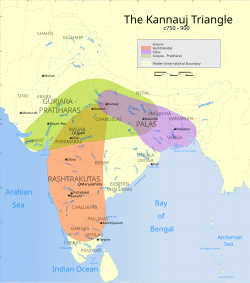Mahendrapala
| Mahendrapala | |
|---|---|
 Pala empire with neighbours | |
| Pala Emperor | |
| Reign | c. 854–860 |
| Predecessor | Devapala |
| Successor | Shurapala I |
| Dynasty | Pala |
| Father | Devapala |
| Mother | Mahata Devi |
Mahendrapala (r. c. 854–860[1]) was the fourth king of the Pala dynasty of the Bengal region of the Indian subcontinent. He was the son of Devapala and his queen Mahata.[2]
Reign[edit]

Mahendrapala has been mentioned in some Pala records, but earlier, the historians used to believe that these mentions referred to the Gurjara-Pratihara king Mahendrapala I. However, the discovery of the Jagjivanpur copper plate charter issued by Mahendrapala made it clear that he was a distinct Pala emperor, who succeeded Devapala.[3] The charter, issued in the 7th year of Mahendrapala's reign (believed to be 854 CE), mentions the construction of a monastery at Nandadirghika Udranga by Mahendrapala's mahasenapati ("great general") Vajradeva.[4] The grant is dated in his 7th regnal year and issued from the Kuddalakhataka jayaskandhavara (the camp of victory).[5]
Mahendrapala was succeeded by Shurapala I.[6] According to the Jagjivanpur inscription, Shurapala I was Mahendrapala's younger brother and royal envoy.[7]
Mahendrapala appears to have retained the Pala control over Bengal and Bihar.[7]
See also[edit]
References[edit]
- ↑ Dilip Kumar Ganguly (1994). Ancient India, History and Archaeology. Abhinav. p. 41. ISBN 978-81-7017-304-5.
- ↑ Dimensions of Human Cultures in Central India: Professor S.K. Tiwari Felicitation Volume. Sarup & Sons. 2001. p. 239. ISBN 978-81-7625-186-0.
- ↑ Debala Mitra; Gouriswar Bhattacharya (1991). Akṣayanīvī: Essays Presented to Dr. Debala Mitra in Admiration of Her Scholarly Contributions. Sri Satguru Publications. ISBN 978-81-7030-275-9.
- ↑ Bengal museum to reconstruct excavated Buddhist site
- ↑ "Jagjivanpur, A newly discovered Buddhist site in west Bengal". Information & Cultural Affairs Department, Government of West Bengal website. Archived from the original on 9 August 2009. Retrieved 18 October 2009.
- ↑ Paresh Chandra Das Gupta; Asok Kumar Datta (1 January 1991). Studies in Archaeology: Papers Presented in Memory of P.C. Dasgupta. Books & Books. ISBN 978-81-85016-29-0.
- ↑ 7.0 7.1 Niharranjan Ray; Brajadulal Chattopadhyaya (1 January 2000). A Sourcebook of Indian Civilization. Orient Blackswan. pp. 621–623. ISBN 978-81-250-1871-1.
| Preceded by Devapala |
Pala Emperor 9th century |
Succeeded by Shurapala I |
